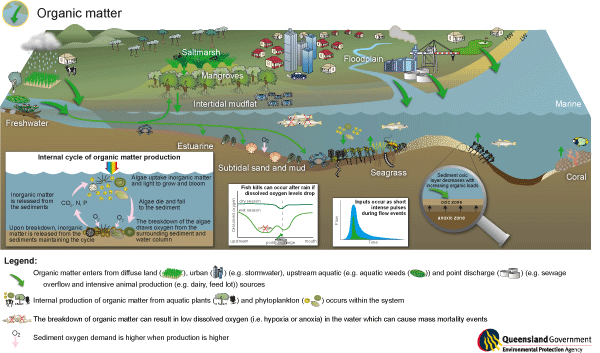Our current best conceptual understanding of the stressor ‘organic matter’ is shown in Figure 1.
Figure 1. Potential causes of a change to organic matter and the condition responses observed as a result of this change.
Organic matter is carbon based material derived from plants or animals (e.g. decaying plant matter or animal wastes) and can be in either dissolved or particulate form. It consumes oxygen when it degrades and is a source of ‘recycled nutrients‘ for water column productivity. Organic matter can enter aquatic systems from external sources (catchment run-off or point-source discharges) or may be generated within the system via photosynthesis. From either source, the organic matter is a primary driver of aquatic food webs. Living organic matter is consumed by secondary producers while dead organic matter is metabolised by bacteria and the breakdown products fuel further production.
Bacterial metabolism requires oxygen and therefore the breakdown of organic matter places an oxygen demand on the system. In undisturbed systems the demand is relatively small and has minimal impact on the system. However, unnaturally large organic loads entering systems can stimulate bacterial activity (and thus increase oxygen demand) to the point where oxygen levels in the system may be reduced to very low levels. This in turn may cause the death of some biota. The increased oxygen demand and subsequent impact on dissolved oxygen levels caused by organic matter is the main stress factor considered here. Different types of organic matter vary greatly in the rate at which they can be broken down. Some types of organic matter break down very quickly and therefore create a strong short-term demand on oxygen, resulting in rapid reductions in oxygen levels. Other types of matter (e.g. cellulose) break down very slowly and therefore have much less marked effects on oxygen levels.



